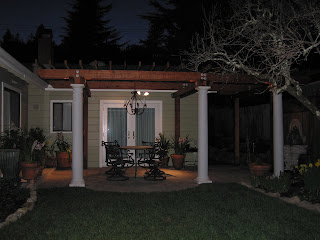
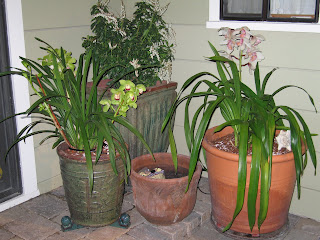


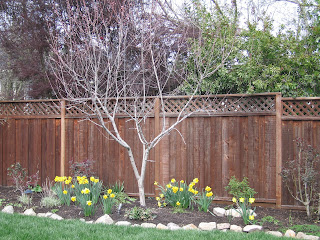 I sprayed the peach tree yesterday, warding off the dreaded Peach Leaf Curl with a foul-smelling liquid the color of battery acid. Only with difficulty could I reach high enough with the hose to spray the topmost branches, reminding me of its first season four years ago.
I sprayed the peach tree yesterday, warding off the dreaded Peach Leaf Curl with a foul-smelling liquid the color of battery acid. Only with difficulty could I reach high enough with the hose to spray the topmost branches, reminding me of its first season four years ago.
That spring, with a mixture of skepticism and hope I planted what looked like a dead stick into the ground. Watching those first peaches develop, swell, and ripen after the show of delicate pink blossoms was a small miracle of spring.
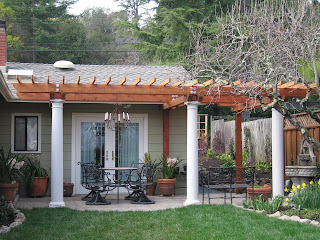 Meanwhile, the pergola is done. Table and chairs, potted plants, and the aforementioned fountain nearby. We had lunch out there the other day… I can’t wait until the roses and clematis are climbing up the columns and over the trellis, but that is probably a couple of years away.
Meanwhile, the pergola is done. Table and chairs, potted plants, and the aforementioned fountain nearby. We had lunch out there the other day… I can’t wait until the roses and clematis are climbing up the columns and over the trellis, but that is probably a couple of years away.
A second coral bark maple has been planted inside the new front gate, where its brilliant color plays off both the front door and a second coral bark maple planted outside the fence. Moving those boulders was no simple task but they frame the tree so nicely, it was worth the effort.
These trees were chosen specifically to fulfill our quest for fall color. While in spring and summer the leaves are deep green and burgundy, in the fall they form a haze of brilliant reds, orange, and gold.
Speaking of fruit trees, the new plum trees are just breaking bud. Told by the nursery plantsman that the Satsuma plum we wanted requires a pollinizer, we opted to bring home a Santa Rosa plum as well (the ideal pollinizer for Satsumas) and plant the two trees in a single hole. A little weird but not unheard-of, and evidently it works. My friend Debby makes the most divine jam with her Satsuma plums… for now I can only aspire to such jam-making greatness.
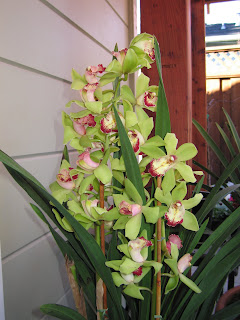
 BRAVE NEW KNITS: 26 Projects and Personalities From the Knitting Blogosphere was released by Rodale, Inc. in August, 2010, and quickly made Amazon’s list of Best Books of 2010, in the Top Ten Craft Books category. It features original creations by a select group of the blogosphere’s celebrity designers as well as some of its most talented rising stars. Half are fashionable and flattering garments, and the other half are stylish accessories.
BRAVE NEW KNITS: 26 Projects and Personalities From the Knitting Blogosphere was released by Rodale, Inc. in August, 2010, and quickly made Amazon’s list of Best Books of 2010, in the Top Ten Craft Books category. It features original creations by a select group of the blogosphere’s celebrity designers as well as some of its most talented rising stars. Half are fashionable and flattering garments, and the other half are stylish accessories.
Copyright © 2025 · All images copyrighted and are not to be copied or reproduced in any manner.
Website design by Holly Knott LLC.